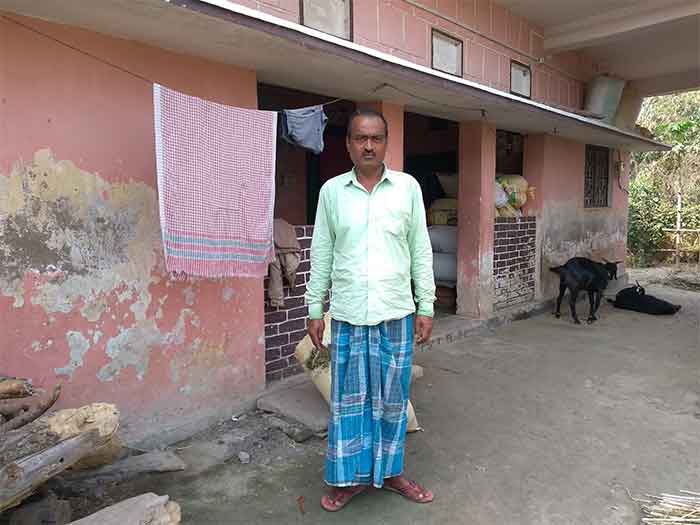
Shamshad Ansari, a resident of ‘Babu Ke Bhatkan’, a village in Siwan district in Bihar, is a matriculation pass and has been working as a driver in Saudi Arabia since 2002. The 35-year-old returned to his home in February 2020, about twenty days before the Covid lockdown in India.
Was it better for him to return before the lockdown? Would he have been otherwise stuck abroad?
“No! I shouldn’t have come back here. If I had stayed in Saudi Arabia it would have been better. We are now trapped in our homes here. Many of my friends remained there and foreign companies took responsibility for them and today their job remains. After our return, we also lost our jobs and over ten lakh rupees of Provident Fund is also stuck now”, says Shamshad Ansari, breaking down as he speaks.
In the first week of March 2022, he along with his other two friends had gone to the Saudi Arabian Embassy in Delhi and given an application there to recover his PF money, but believes that most likely he will not get his money. The company there has shut down, Shamshad Ansari’s application for a new visa has also been rejected. Shamshad Bhai, in despair, explains that he cannot go to Saudi Arabia anymore.
Shamshad Ansari was earning 35-40 thousand rupees a month while living in Saudi Arabia. But, in and around his village, he cannot find any seth who will agree to keep him for the driver on a regular basis.
According to Shamshad, “Even if you get work for one day, you have to sit idle for ten days.”
Folk artist Pankaj Ram from the same village tells us that Shamshad is also a small farmer. He grows crops like mustard, wheat, paddy, etc. in his field. Their produce is so little that it is difficult to get enough food for the family members. He owns a cow but it is still not fit to give milk as it is still young and will take a long time before it provides any milk.
So what is Shamshad planning to do?
“I can’t go abroad, so I am still thinking what else I can do,” he says. He slowly explains, “In Saudi Arabia, Dubai, Qatar, etc., only young people are in demand for jobs. After an age limit is reached, the companies there do not hire. You will be struck off at the interview stage itself”.
 So the thing is, a person who has been a driver for 15-20 years, and who does not have any other skills apart from driving, if he becomes unemployed, then where will he go in this condition, from whom will he ask for work? Looking for a new job!
So the thing is, a person who has been a driver for 15-20 years, and who does not have any other skills apart from driving, if he becomes unemployed, then where will he go in this condition, from whom will he ask for work? Looking for a new job!
“At the time of the lockdown, there was an exemption that those who want to go to Saudi Arabia can go there, but this exemption was only for a few days. Those who were in Delhi flew from there but those like me from a village in Bihar just stayed here! Only one in five men could go back to work in Saudi Arabia!” says Shamshad.
Pankaj counts the names of those with similar tales. Mustafa Ansari, Jabbar Ansari, Nagender Ram and Sai Ram who returned from abroad to the village and are now stuck here jobless.
Shamshad Ansari, narrating his pain, says, “At a time when we need work the most, many boys of the village were expelled from the country but now we were also expelled from abroad!”
We can understand the meaning of what he says. They are deprived everywhere in terms of work. It is obvious that in view of the number of unemployed in the state, the demand for employment can be met only by the government. But the administration gives everyone assurances, hope, comfort – everything except a real job.
This is not surprising given the dire state of unemployment and migration in Bihar. In the year 2020 at the time of the first lockdown, according to the government data, 19 lakh 27 thousand 500 migrant laborers from 21 states had returned to their homes in Bihar. Of these, the maximum – 3 lakh 67 thousand returned from Gujarat, followed by 2 lakh 90 thousand from Maharashtra, 2 lakh 3 thousand from Punjab, 2 lakh Uttar Pradesh. Similarly, the number of laborers returning from Tamil Nadu and Karnataka was also more than 1 lakh each.
The repeated lockdowns and restrictions on movement nationally prevented many migrant workers from returning to their places of work. In the meanwhile powerful leaders in the state, ministers, MLAs, concerned officials, all of them claimed repeating the same thing in their speeches and statements that they will provide employment to over 20 lakh people of Bihar.
On 1 July 2021, from the state’s Labor Resources Minister Jivesh Kumar to the top officials of the Labor Department, everyone continuously claimed that everyone will be given employment, but there was no clear roadmap. Journalists with knowledge of this issue say that neither new industries were established in Bihar nor efforts made to start old closed industries during this period.
Covid Response Watch spoke to Siwan based journalist Abhishek Tiwari about this issue. According to him, once upon a time a network of sugar, jute, paper, yarn and silk industries was laid out in Bihar, but currently the entire industrial structure has collapsed. Some blame the faulty process of selection of schemes and some blame the lack of a proper monitoring mechanism together with corruption.
There was a time after Independence when 40 percent of the country’s sugar came from Bihar alone, but in the meantime many sugar mills kept closing one after the other. The list includes SKG of Siwan, Sakri of Darbhanga, Lohat, Rayam, Balmkhani of Purnia, Hasanpur sugar mills of Samastipur, Motipur sugar mills of Muzaffarpur.
Similarly, the jute mills of Purnia, Araria, and Katihar were also closed. The reason behind this is said to be the problems of state-level politics spreading to the local level. The factories of cement, paper and vegetable oil in Dalmia Nagar of the Rohtas industries group were also closed. At the same time, the silk and handloom industry of Bhagalpur, popularly known as Silk City, also suffered due to lack of electricity, poor law and order and administrative apathy. While on the one hand the old industries kept getting closed, on the other hand new investment did not come into the state.
Similarly, after Covid lockdown, the state government had also decided to set up at least two industrial clusters in each district. In this regard, Pushyamitra, a senior journalist based in Patna, tells us that this scheme of the state government too has not been implemented properly.
According to the 2011 census, 93 lakh people migrated from Bihar to other states in search of employment between 2001 and 2011. This was the situation a decade ago. This number indicates that up to 9 percent of the population of Bihar has to leave home, village, state just due to the compulsion to survive.
Shirish Khare has been associated with rural journalism for a long time and has been continuously reporting on the economic, social and health impacts of rural life during the Corona pandemic.













































